By Philip Cauchi
Level of ability: Ideally the players should have a sound technical foundation in passing and receiving the ball under opposition pressure. Therefore the players should be able to understand basic visual communication, perceive key stimuli to make decisions, and pass the ball (execute the decision) with accuracy.
Adaptations: To increase the time and space the players have on the ball (easier variation) increase the area of practice. Otherwise to make it harder and play at a higher speed (quick decision making) decrease the area of practice so to decrease the time and space the players have at their disposal. We can also keep the same area and decrease the number of players to make it easier for our players.
Aim: To create a scoring opportunity upon winning possession from a deep position.
Team function: Offensive transition (winning the ball).
Key concepts:
1. Open up on winning the ball.
2. Create space – move away from the ball when in front of it so to create more lines.
3. Break lines.
4. Play vertically.
5. Attack the space behind the opponents’ back line.
6. Follow the attack.
Practice 1: Play forward quickly to finish on mini goal.
Training load: Play two sets of three minutes. Rest for three minutes between sets while performing dynamic flexibility exercises.
Total duration: 9 minutes.
Preparation: The team is divided into two groups. In each group the players are paired. One of the pair has a ball at her feet. The groups are positioned twenty yards away from the mini goal in front of them.
Description: Groups compete with each other how many goals they score in the allotted time. The first pair of each group starts by the player with the ball passing the ball forward to the other player who will return the pass into the space between the two cones assigned for the group. The player receiving the ball behind the line of the cones has to finish on the mini goal with a first time pass. After finishing on the mini goal, the next pair in line take their turn after the player on the ball is tagged by any of the two players who participated in the previous round. The ball must be kicked at the mini goal on the third kick. If the players take more than one touch to finish on the mini goal and a goal is scored, it will not count.
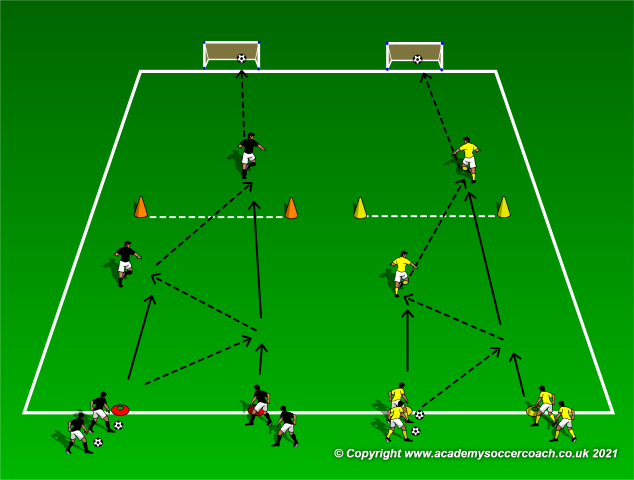
Practice 2: Receive the return ball to finish on goal.
Training load: Play four sets of two minutes. Rest for two minutes between sets while performing dynamic flexibility exercises.
Total duration: 14 minutes.
Preparation: The team is divided into two groups. In each group there are three positions; position A, position B and position C. The player at position A has the ball. The goalkeeper of the opposite group is positioned in the goal twenty five yards from position A.
Description: The player at position A plays a vertical pass to player C who will then lay the ball to player B who has followed player A’s vertical pass. Player B finishes on goal. After each shot the players move one position. The player at position A moves to position B, the player at position B moves to position C, while the player at position C moves to position A. Group compete against each other for how many goals they can score. The number of goals for each round are kept and then the final tally is compared. After each round the groups change areas so to finish at goal from different angles.
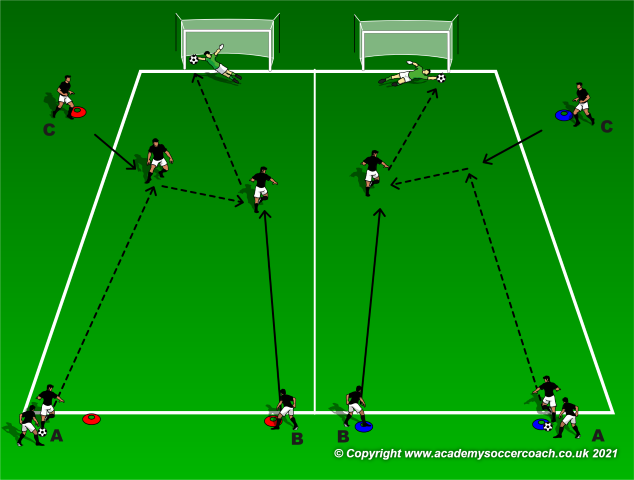
Practice 3: 4v4 + 2 with goalkeepers – fast break from deep.
Training load: Play two sets of four minutes. Rest for two minutes between sets.
Total duration: 12 minutes.
Preparation: The area of play should measure fifty yards by thirty yards. An area measuring twenty yards by thirty yards is marked at one end of the major area. This is known as the defending zone for the team defending the respective goal. A goalpost is placed at each end line. Two teams of four outfield players and a goalkeeper are formed. Two other players are neutrals and play as wingers for the team in possession of the ball.
Description: The attacking team (blacks) start with the ball inside the defending team’s zone. Their aim is to score while the defending team aim to recover the ball and initiate the counter attack in the opposite goal with the help of the wingers who give the team in possession a numerical advantage and also width. Whenever the ball goes out of play or a goal is scored, the game is always restarted by the team in possession from the edge of the defending team’s zone. After the first set of four minutes are over teams change roles.
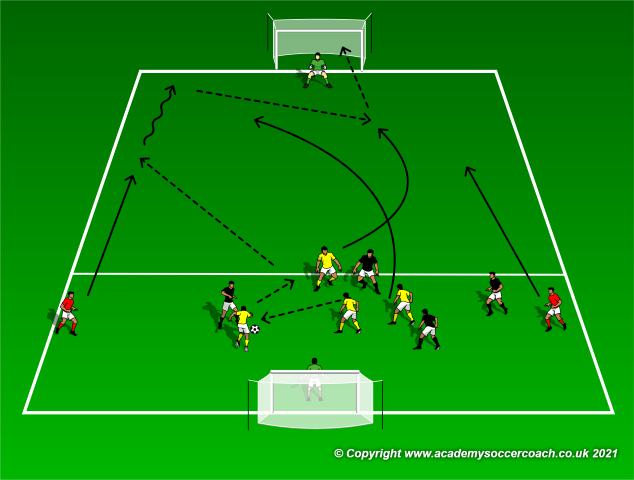
Practice 4: Counter from deep – Small-sided game.
Training load: Play two sets of four minutes. Rest for two minutes between sets.
Total duration: 12 minutes.
Preparation: The same area from practice 3 is kept. However, now both teams play with equal numbers of five outfield players and a goalkeeper. The players are positioned as follows: The attacking team (blacks) have a goalkeeper in goal, four players inside the defending team’s zone and a defender positioned inside the bigger area. The defending team have a goalkeeper in goal two defenders and two forwards.
Description: The attacking team (blacks) start with the ball inside the defending team’s zone. Their aim is to score while the defending team aims to recover the ball and initiate the counter attack in the opposite goal. On recovering the ball the yellows may either play the ball to the striker or dribble it into the major area in order to create a 3v2+GK situation against the blacks. Whatever the outcome (the ball goes out of play or a goal is scored) the game is always restarted from the edge of the defending zone. The offside rule is not in effect. After the first set of four minutes are over teams change roles.
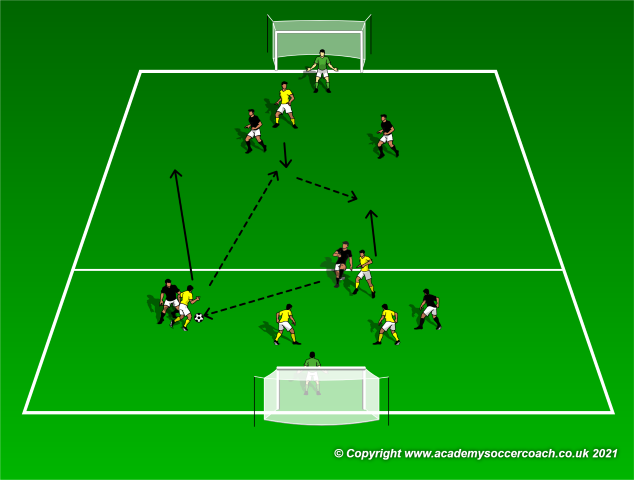
Practice 5: 4v4 with goalkeeper and two neutral wingers – Small-sided game.
Training load: Play four sets of four minutes. Rest for two minutes between sets.
Total duration: 22 minutes.
Preparation: The same pitch dimensions of the previous two practices are kept. A central line is marked. Two teams of four players plus a goalkeeper are formed. Two neutral wing players play with the team in possession.
Description: One team starts the game inside the opponents’ half as shown in the diagram hereunder. Teams must have all their team members inside the opponents’ half in order for a goal to count. This includes the neutral wing players. The offside rule is in effect. When a team wins the ball they must aim to quickly exploit the space behind the opponents’ back line in order to score.
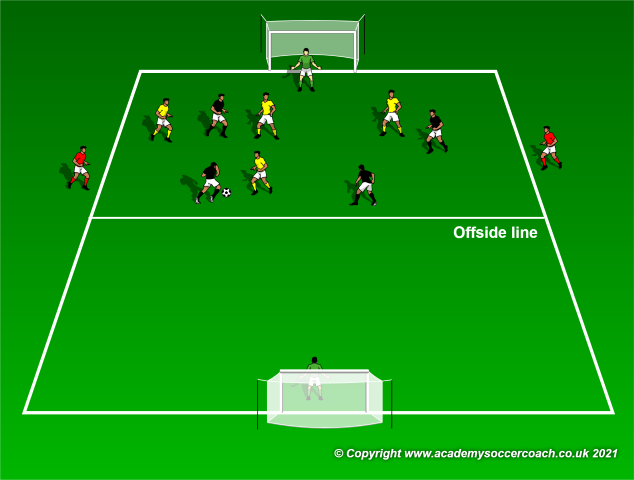
Cool down: Players in pairs passing the ball inside the area while moving. The sessions ends with static stretching exercises.
Duration: 8 minutes.
By Philip Cauchi


